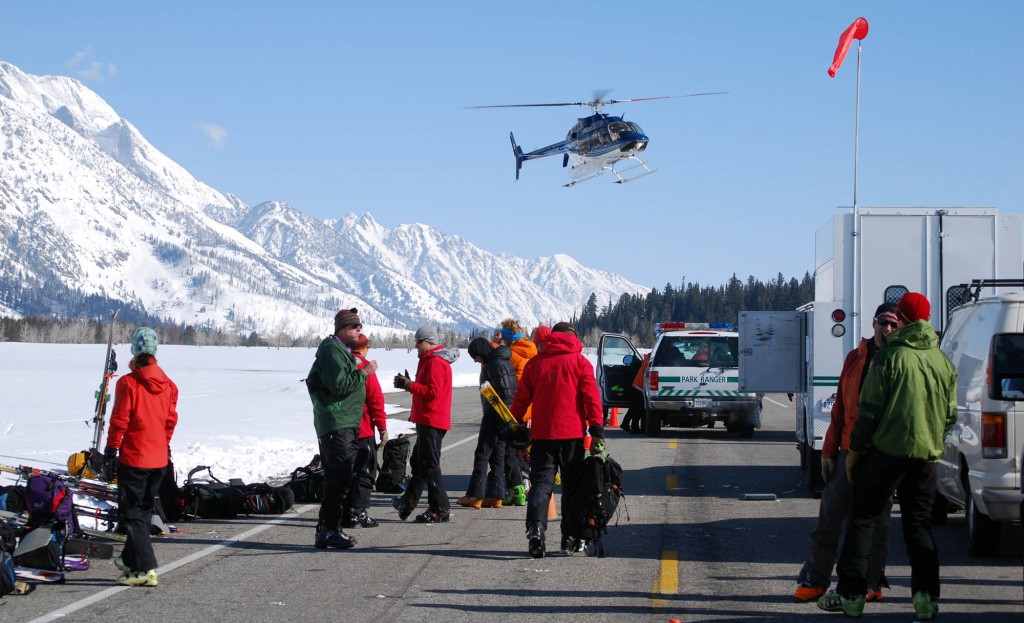
Rescuers set up a temporary heliport on Teton Park Road to transport people and rescue dogs to Garnet Canyon during the April search for lost skiers. (National Park Service photo by Jackie Skaggs — click to enlarge)
By Rone Tempest/WyoFile
LANDER — The first sign that something was wrong came Monday, April 18, when Walker Kuhl, a Salt Lake City federal bank examiner, failed to show up for work.
Kuhl, 27, and his climbing buddy, Montana emergency room doctor Gregory Seftick, 31, had gone on a weekend backcountry ski trip to Grand Teton National Park, intending to explore the Teepe Pillar and Teepe Glacier features of 13,770–foot Grand Teton.
More than a week later, after what is believed to be the most expensive search and rescue operation in Grand Teton National Park history, Kuhl and Seftick’s bodies were found still tucked in their sleeping bags, crushed by a massive April 16 Garnet Canyon avalanche that buried them under 13 feet of snow.
According to Teton County Deputy Coroner David Hodges, the two men, both superbly fit and experienced mountaineers, died of asphyxiation within minutes of the avalanche. Rangers at the scene found no ice crystals near the men’s faces that would have indicated they had been breathing for any significant period of time after the slide. At that depth, the weight of the snow on their bodies was between 195 and 260 pounds per square foot. Hodges believes the immense pressure on their diaphragms prevented them from drawing a breath.
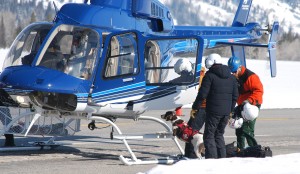
Jason O'Neil and his dog, Murphy, with the Grand Targhee Resort ski patrol and canine team, board a helicopter April 23 to search for lost skiers in Garnet Canyon. (National Park Service photo by Jackie Skaggs - click to enlarge)
“I don’t think that they had a conscious thought of their impending death,” said Hodges. “Death was rapid if not instant.”
But back on the morning of April 18, when Kuhl’s girlfriend reported him missing, park officials were uncertain about the skiers’ whereabouts.
Imbued with a proud National Park Service tradition of saving those who can be saved and recovering the bodies of those who can’t, personnel from the Jenny Lake Ranger Subdistrict launched an extensive search that was often complicated by difficult weather and technical problems.
Three more feet of snow fell on the searchers as they hunted for the two missing men, probing the snow with standard 10-foot telescoping metal poles. Under the new layer of snow, however, the Kuhl-Seftick campsite was now well below their reach.
“I’m sure we probed right over the top of these guys’ bodies,” said Jenny Lake Subdistrict Ranger Scott Guenther.
The Teton County Search and Rescue helicopter that the Park Service leased for the search — at a cost of $33,000 — was grounded repeatedly by bad weather. According to park spokeswoman Jackie Skaggs, the rescue-recovery operation cost $115,000 — more than double any previous search on record at Grand Teton.
A tradition of rescue and recovery
America’s national parks have a tradition of coming to the rescue of visitors in trouble and recovering the bodies of those who die on park grounds. In 2009, the most recent year for which national records are available, Park Service workers conducted 3,568 search and rescues that cost a total of more than $4.8 million.
“We average about $5 million a year taken from our general funds,” said Jeffrey Olson, a Park Service spokesman in Washington, D.C.
Most search and rescues are relatively simple matters: a child wanders from a campsite in Yellowstone National Park; boaters have too much to drink in New York City’s Gateway National Recreation Area; an elderly visitor gets disoriented in Yosemite National Park.
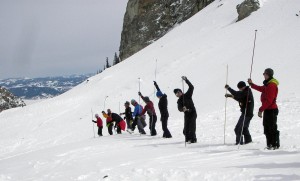
Rescuers use poles to probe an avalanche debris field while searching for two lost skiers April 19 in Garnet Canyon in Grand Teton National Park. (courtesy photo by Jay Pistono - click to enlarge)
But in some of the more remote and rugged parks, searches are very costly. In the past five years, for example, Alaska’s Denali National Park has had three prolonged searches that cost taxpayers $127,000, $132,000 and $118,000 respectively, according to Denali spokeswoman Maureen McLaughlin. Neither the people rescued nor the families of those whose bodies were recovered were charged for the Denali operations.
Nor were the families of Walker Kuhl and Gregory Seftick at Grand Teton.
In light of the national budget crisis, Denali and other parks are exploring the idea of charging additional “special use” fees for particularly hazardous adventures. Denali recently proposed charging a $500-per-climber fee to scale Mount McKinley.
Climbing organizations such as the American Alpine Club and Access Fund accept “special use” fees in principle but contend $500 is too high.
“The question is whether people who are engaged in high-risk activities pay more,” said Alpine Club executive director Phil Powers. Powers said his non-profit organization has recently begun offering climbing insurance to its members that covers up to $5,000 in rescue costs.
On May 17, Powers himself was seriously injured in a fall outside Golden, Colorado that required rescue by the Golden Fire Department and evacuation by helicopter to Denver. (For more on this incident see Pitch).According to Alpine Club spokesman Luke Bauer, the rescue would be covered by the membership insurance.
As yet, nothing similar to the Denali fees has been proposed for Wyoming’s Grand Teton and Yellowstone National Parks.
Some national park policy experts have proposed reforms in the search-and-rescue accounting system.
Travis Heggie, Recreation and Tourism Studies professor at the University of North Dakota, in 2009 published an article in the Wilderness and Environmental Medicine journal, examining search and rescue operations in all the national parks from 1992-2007.
A former risk assessment officer with the Park Service in Washington, D.C., Heggie contends that the actual cost of search and rescue operations in the parks is underreported.
“I think if all the dollar figures were added — such as hidden equipment wear-and-tear and medical costs — there would be a doubling of the true search and rescue figures,” Heggie said in an interview with WyoFile.
The problem, said Heggie, is not the money, which in 2009 averaged $1,345 per incident. Even at the $10-million-a-year figure that he thinks is a more realistic total, the annual cost of search and rescue in the 394 national parks is a tiny fraction of the Park Service’s $2.75 billion annual budget.
Moreover, search and rescue efforts save hundreds of lives each year. In 2009, the Park Service reported 370 “saves” — defined as a rescue where “death or serious harm” would have occurred without Park Service intervention.
But Heggie said that paying for search and rescue by taking the money out of the Park Service general funds — as is the current practice — “pilfers” resources from other valuable programs.
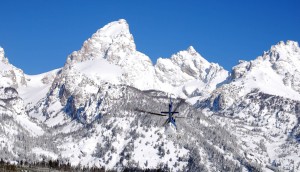
A helicopter heads toward Garnet Canyon in April during a search for two lost skiers in Grand Teton National Park. (National Park Service photo by Jackie Skaggs - click to enlarge)
“Trust me,” said Heggie, “it really comes out of the interpretive division that is on the front lines of the people coming into the park. These are the people who greet you at the visitor center and the ones who give you the guided tours.”
The solution, said Heggie, would be to have “a designated search-and-rescue fund at the highest administrative level.”
“We know it [search-and-rescue] is happening every year,” said Heggie, “so it would be better to have a fund rather than just stick a hand in the bag and take it from someone else.”
Another way to tackle the cost of search and rescue, Heggie said, would be to borrow a page from European countries, where alpine mountaineers and other adventurers are required to have private travel insurance that pays for search, rescue and medical treatment.
“Maybe people like these guys going into the Teton ought to be carrying some kind of insurance,” Heggie said.
Unlike Europe or South Asia, where Pakistan and other Himalayan countries require climbers to post security bonds, the United States as a rule does not charge people for searches or rescues in its national parks. About the closest we’ve come to it are park officials citing someone for creating a public nuisance.
Oppose billing for rescue
Most experienced park rangers, in fact, are opposed to the idea of sending a bill to those they rescue.
“I absolutely do not think that people should be charged for rescues based on the experience of these high-risk users,” retired longtime Grand Teton National Park ranger Renny Jackson told WyoFile. “Are you going to charge for kids lost in a campground?”
Said Olson, the Park Service spokesman and a budget expert: “Our policy is that if we start charging for search and rescue, people would not ask for help or would delay asking for help. We could see that it would easily drive up the cost. When somebody is in trouble we want to go out there and bring them back alive. We like to sleep at night.”
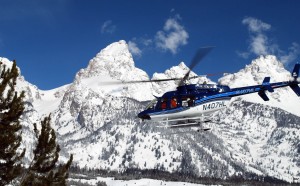
Rescuers used a helicopter leased from Hillsboro Aviation on April 23 to ferry more than 35 people and four dog teams into Garnet Canyon in the Teton Range during a search for lost skiers Walker Kuhl and Greg Seftick. (National Park Service photo by Jackie Skaggs — click to enlarge)
Searches like those for Walker Kuhl and Gregory Seftick, which cost more than $100,000 — a Park Service trigger point that requires approval in Washington— are rare.
“Last year,” said Olson, “we had 3,849 search and rescue efforts and only 832 of those cost more than $500. That means that 79 percent of search and rescue operations last year cost less than $500.”
According to Skaggs, Grand Teton National Park “averages” 15-30 major search-and-rescues a year. But even in a busy year like 2003, which included a daring rescue of 13 climbers who had been struck by lightning on Grand Teton’s Friction Pitch, the search and rescue bill for the entire year was $160,000. The bill for just the Kuhl-Seftick search was $115,000, including $18,000 in wages for park employees reassigned to help in the effort.
National parks are not legally required to conduct search-and-rescue operations, although Park Service management policy does instruct employees to “make reasonable efforts to search for lost persons and rescue sick, injured, or stranded persons.”
In addition, a landmark 1991 federal appeals court decision found that park rangers have almost complete discretion in deciding whether to order a search and rescue operation. The case, Johnson v. United States, involved an inexperienced climber named Ben Johnson, who in 1987 became separated from his friends after climbing Buck Mountain in Grand Teton National Park.
Rangers found Johnson’s body the next morning in a melt pool near Timberline Lake where he had died from hypothermia the previous night.
Johnson’s parents sued the Interior Department, alleging that park rangers failed to “adequately regulate climbing in the park”; failed to launch a prompt rescue effort after a companion of Johnson reported him missing; and failed to conduct a reasonable search when they finally went looking for him.
The case drew considerable national attention among outdoors enthusiasts fearful that a ruling in favor of the parents would greatly restrict public access to potentially or — as in the case of climbing — obviously dangerous wilderness areas. To avoid liability, the government would have to curtail risky activities in which safety could not be assured.
In dismissing the claim on the grounds of subject matter jurisdiction and policy discretion, the 10th U.S. Circuit Court of Appeals in Denver said ruling otherwise would “jeopardize the Park rangers’ autonomy to make difficult, individualized search and rescue decisions in the field. We seriously doubt Congress intended to expose these decisions to the second guessing of courts far removed from the exigencies of the moment.”
Current and former park rangers are well aware of the decision and its implications. The Johnson decision grants rangers authority similar to that of a captain at sea when it comes to rescue or recovery missions. Among other things, the decision meant that rangers could put the hazards faced by the rescuers first and foremost in deciding whether to make a rescue.
Recovery an easier decision
The decisions are easier when rangers know the object of their search is already dead. In 2009 there were 151 fatalities in national parks.
“On the one hand,” said Renny Jackson, “you like to return people to their loved ones. However, putting your life at risk for the return of a dead body is not something you want to do.”
Jackson recalled a case in the 1980s when a rescue team spotted the body of a fallen climber in a couloir— or steep, narrow opening— below a Teton formation known as Molar’s Tooth. Searchers decided the risk of ongoing rockslides made it too dangerous to make a recovery. The body, said Jackson, is still there.
According to deputy coroner Hodges, Walker Kuhl and Gregory Seftick had been dead nearly two days before rangers began their search on April 18. But until their bodies were found a week later, the rangers diligently went about their work in hopes the campers were still alive.
“Until we actually lay hands on the dead bodies, I’m not ready to write anyone off,” said Guenther, who commanded search operations.
The first ranger assigned to the case on April 18 was incident duty officer Chris Harder, who found the missing skiers’ two vehicles at the Taggart Lake trailhead. A check that afternoon with the ranger office in Moose revealed that the two men had obtained the necessary backcountry permits and told the staff they were headed to Garnet Canyon in hopes of exploring Teepe Pillar and Teepe Glacier. (Ironically, the features were named for Theodore Teepe, an early mountaineer who died in a climbing accident in 1925).
Other skiers reported seeing two men resembling Kuhl and Seftick in the area on Saturday.
“Another party of four had seen them,” said Guenther. “Now we had them in Garnet Canyon. By Monday night we really ramped up and knew we were going to have a big search.”
The rangers managed to get the leased helicopter into the Garnet Canyon area during a brief window on the evening of April 18, but erratic winds and poor visibility hampered their efforts.
On Tuesday, April 19, four-person teams skied into Garnet Canyon and the helicopter made another sortie in hopes of spotting the two men or their campsite.
As weather cleared on Wednesday, April 20, the searchers mounted their biggest effort yet, with more than 60 people on the ground. Rescue teams with avalanche transceivers, probe poles and sonar devices were joined by two canine search teams.
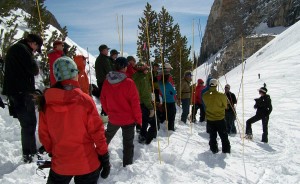
Searchers are briefed before using probe poles to search an avalanche debris field in Garnet Canyon. (National Park Service photo by Mike Nicklas - click to enlarge)
Because of the difficult weather, continuous threat of avalanche and generally hazardous conditions, Guenther deployed a mixture of trained park employees and professional searchers, paid $27 to $37 an hour, to do most of the work. The teams included trained rescuers from Teton County Search and Rescue; Teton Interagency Fire; Bridger-Teton National Forest and Bridger-Teton National Avalanche Center; Jackson Hole Mountain Resort Ski Patrol; Wyoming K-9 Search and Rescue; Grand Targhee Resort Ski Patrol and canine teams and mountaineers from Exum Mountain Guides and Jackson Hole Mountain Guides.
Driven to continue
Guenther said he felt driven to continue the search because of an experience he had in 1995 when he was working as a seasonal climbing ranger in the park. A 25-year-old climber from Oregon named Aaron Gams disappeared near the summit of the Middle Teton as a winter storm swept into the range.
“We spent two days out there looking for him and I was sure he was dead,” recalled Guenther. “But I was standing on the summit of the Middle Teton and here was this guy sitting on a ledge. Ever since then, I’ve been reluctant to give up hope.”
Guenther said the mounting cost of the Kuhl-Seftick operation was never a major factor in his decision.
“We look for efficiencies but in my time as a ranger we have never made a determination to go out based on cost,” he said.
But by Friday, April 22, still with no sign of the missing men, Guenther talked to the men’s families, informing them the search would scale down to a “limited continuous response.”
“I told them that we would do the most thorough search we could on Saturday, but that after Saturday we are probably going to be scaling back,” said Guenther. “But on the eleventh hour of that last day we finally found something — a beacon hit by one of the searchers.”
On literally the last sweep of the day, Saturday April 23, ranger Nick Armitage picked up a signal on his avalanche transceiver. Although most backcountry skiers turn off their avalanche beacons in the campsites, Kuhl and Seftick had left theirs on.
To create a way for people who have been rescued or their families to support search and rescue, several national parks have created non-profit funds where citizens can make tax-deductible contributions. The Grand Teton Association, the nonprofit organization that runs the park bookstores and other enterprises that benefit the park, recently created the Jenny Lake Ranger Fund so people can donate money for additional training and equipment. “This gives people like grateful families a place to donate and support search and rescue without giving directly to the government,” said association executive director Jan Lynch. Donors can send checks to the Jenny Lake Ranger Fund, c/o Grand Teton Association, P.O. Box 170, Moose, WY 83012.
The search teams “dug like heck” through the dense snowpack and picked up a second signal before it became too dark for the helicopter to land. They returned on Sunday, April 24, and found the two men’s bodies.
In a website created to honor Walker Kuhl, an Iraq war veteran who studied Arabic upon his return to college, the families posted a thank-you notice:
“We thank the National Park Service and all the people involved in the rescue efforts of our sons Greg Seftick and Walker Pannell Kuhl. We recognize that the rescue mission required hard work under trying conditions over many days. We appreciate the professional and caring manner in which the mission was carried out.”
Still in Jackson Hole after his 1995 brush with death, Aaron Gams, now 40 and a massage therapist, recalled his own gratitude to Guenther and the Jenny Lake rangers. Gams, whose core temperature dropped to 86-degrees before he was rescued, lost eight of his toes to frostbite.
“I put all those guys in a precarious place. There were more than 40 people looking for me,” Gams said. “I was in late-stage hypothermia. I was hallucinating and believing all the hallucinations. I don’t think I would have lived for another hour if they had not found me.”
Gams said his medical care after the incident cost him more than $20,000 but that, for him, the national park rescue was free.
“I would have been glad to pay for the rescue if they had asked me,” Gams said. “But at the same time I’m really glad they didn’t give me a bill.”
This story was originally published May 24, 2011 at WyoFile, an online news service focused on Wyoming people, places and policy. WyoFile consulting editor Rone Tempest is a former Los Angeles Times national and foreign correspondent who lives in Lander. Contact him at rone@wyofile.com.
